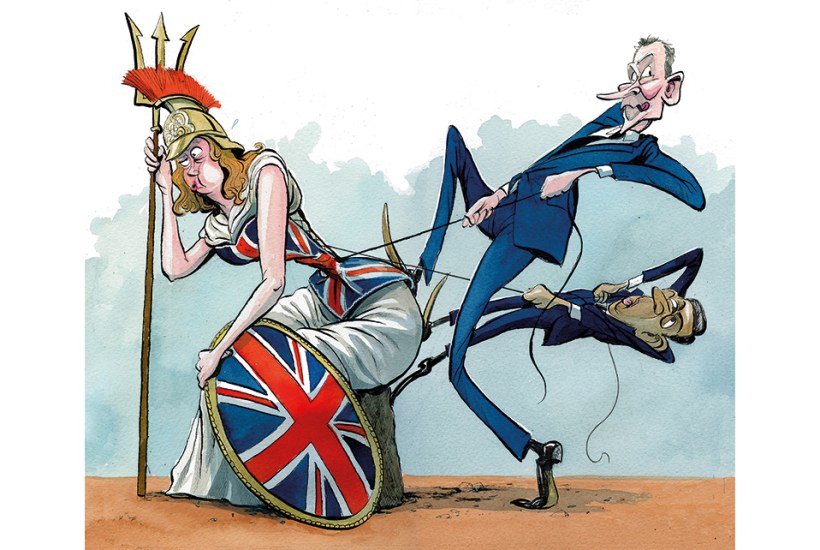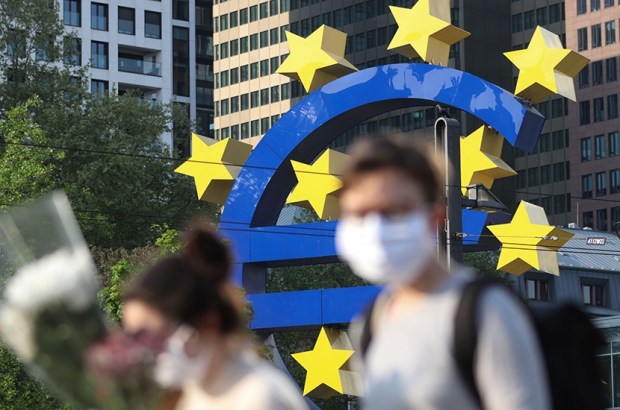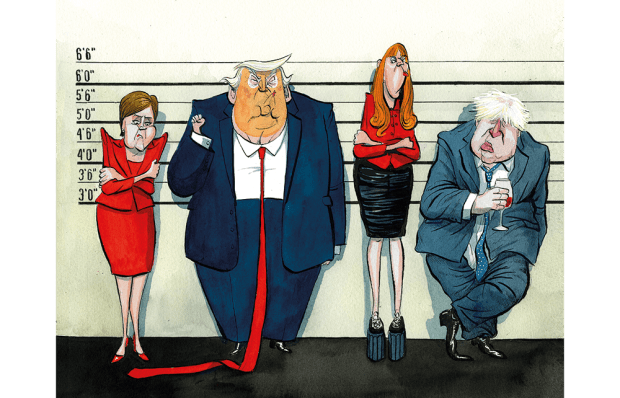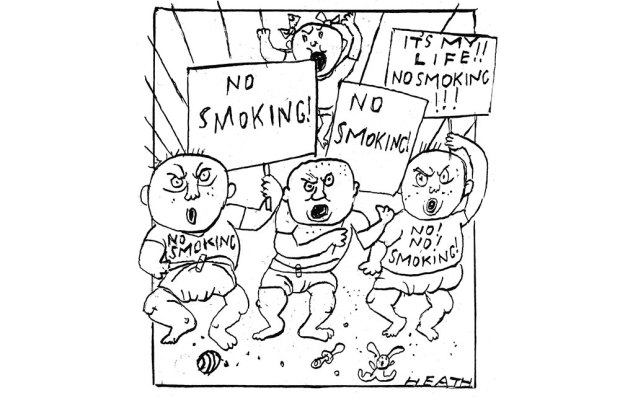Rishi Sunak has ushered in a new era of austerity, not just Osborne-style spending cuts, but tax hikes as well. His Chancellor, Jeremy Hunt, says the plan is not just to balance the books but to control inflation, and so this will be the theme of the Sunak years: Austerity 2.0.
Throughout the leadership campaign, Sunak repeatedly argued that persistent high deficits were no longer an option. Difficult decisions lay ahead, he said, and claims to the contrary were ‘fairy tales’. His critics said this was a safety-first ‘Treasury view’, and Britain had plenty of scope to borrow more. But Sunak was certain that the debt racked up during the pandemic – not just by Britain but countries the world over – guaranteed a wake-up call at some point. The call came when Liz Truss and Kwasi Kwarteng tried to keep up the borrow-and-spend agenda. Now Sunak and Hunt are trying to respond.
The solutions they propose won’t be pretty. Britain appears to be entering into a phase – under the Tories, no less – where taxes are going to keep creeping upwards until growth trends improve. It’s no sort of solution, as the former rarely leads to the latter. Where will growth come from? And is there any end in sight to the misery?
This is the missing piece of the puzzle Sunak has yet to find, despite the urgency that he does. Hunt’s Autumn Statement came alongside news that inflation hit 11.1 per cent on the year to October, outpacing predictions yet again. The Bank of England’s growth forecasts run to 2025, by which time it expects the UK to be the only major country whose economy will not yet have recovered to pre-pandemic levels. We’re not just looking at the worst growth rates in the G20 or Europe, but anywhere in the developed world.
Truss defined her agenda as ‘growth, growth, growth’, while Sunak’s camp seems to embrace ‘tax, trim, wait’. There is a strong case, as we learned during Truss’s short-lived premiership, for fiscal credibility to take priority; tax cuts should only be made as a reward for the economy getting back in shape.
But the waiting period is going to be painful. The best-paid will continue to contribute the most, with pension restrictions and tax rates syphoning off 47 per cent of their income. But some workers earning a lot less will be in an even worse position. A recent graduate earning £51,000 a year with outstanding student loans will be paying a staggering marginal rate of 51 per cent. That’s a big salary, no doubt – but many of those in London, say, will be paying up to half their post-tax income in rent.
Much of the tax pain will be driven by ‘fiscal drag’, where workers get pulled intohigher tax brackets that have not been adjusted for inflation. An additional 1.5 million workers can expect to be landed in the 40 per cent (or more) tax bracket over the next three years, including some teachers, nurses and police officers. In many cases, workers will be paying more tax while simultaneously experiencing a real-terms pay cut: the average worker will have a 3 per cent dip in salary, as wage hikes fall behind inflation. Another million part-time earners – on £12,500 a year – will be dragged into paying income tax because of the frozen personal allowance threshold. Cleaners, security guards, parents doing part-time work to make ends meet – they’ll be hit too. Some of the welfare-to-work premiums will let someone on Universal Credit keep just 45p of every extra pound they earn.
This jars because ‘strivers’ are supposed to be the core Tory voters, but there’s only so much tax the top 1 per cent can be expected to provide: they earn 13 per cent of all money paid as salary, but contribute 28 per cent of all income tax collected. If state spending surges, ordinary workers will pay for it. No political party – Tories or Labour – sets out to squeeze everyone in every tax bracket; it’s the consequence of having an increasingly interventionist state. The government machine is now 50 per cent bigger than it was under Tony Blair. Everyone has to pay more to keep it grinding along.
Back when Sunak was in No. 11, he would ask: what type of country does Britain want to be after Brexit? A lower-tax, lower-spending country, or a European-style social democracy with a tax burden similar to France and Germany? He favoured the former, but that wasn’t his main point. He felt that there was no honest debate taking place about the trade-offs; that under Boris Johnson the UK was thoughtlessly and irreversibly drifting into the big-state model, and if the Tories kept making large spending pledges, higher taxes would inevitably follow. Britain would, he thought, become a big-state European spender by default.
In an effort to avoid this drift, Sunak often tried to make himself the barrier between requests for more money and the green light. ‘In my experience, he was always the one to shut down more spending,’ says one minister. ‘I respected that, but plenty of my colleagues did not.’ This is one of Sunak’s biggest political problems now, both with his fellow MPs and the public. It’s not politically popular to refuse more cash, especially when the country has been hooked on cheap money for so long.
Sunak became known in some circles as the ‘undertaker’ on the summer leadership campaign trail, because he showed up at hustings to deliver grim news about the health of public finances and the UK economy. His diagnosis was one that many people, both in and out of the Tory party, didn’t want to hear – not least because Sunak has a decent track record for predicting these things. He was one of the only politicians in the UK to prepare people for the possibility of inflation. His warnings around Truss’s economic plans were quickly vindicated too.
But the mission now is not simply about correcting the errors of the Truss era. If it were, Sunak and the Chancellor would have a fairly easy job on their hands: just their arrival into Downing Street soon took UK borrowing costs back down to where they were before the mini-Budget. What those 44 days of Truss did ensure, however, was that the UK would be the first major country to be singled out by the newly resurgent bond markets and made to pay the price of the unaffordable spending promises that were made before and during the pandemic.
Sunak suspected, when he reluctantly went along with the repeated lockdowns, that they would cause long-term economic damage. Privately, he accepts he didn’t foresee that so many people, especially over-fifties, would not return to work. While early retirement is a global trend post-pandemic, Britain is the only advanced economy in which economic inactivity levels (i.e., people not in work, nor looking for it) have been consistently on the rise even after lockdowns ended.
It might not be formally declared yet, but Britain is probably in recession already – a recession made worse because a million people have left the labour force.
Earlier this week, new figures for the number of people on benefits came out, not via a press release, but on a password-protected government website. The number of total claimants, it turns out, is 5.2 million. The depth of the problem in many British cities is severe: Blackpool, Middlesbrough and Liverpool have an unemployment rate for working-age adults of 24 per cent, 22 per cent and 20 per cent respectively. Some of those people do have long-term health conditions, but not all of them. Considering that job vacancies are at a near-record high nationally – over 1.2 million – it’s possible that this recession will look very different to previous contractions. It’s not that people can’t find work, but that a flawed welfare system is encouraging many to stay at home.
The figures are usually buried in Westminster, and updated with a six-month lag. There is a growing acknowledgement in Sunak’s cabinet, however, that this government must address the question of how to turn healthy, working-age benefit claimants – some of whom are estimated by Whitehall to cost the taxpayer £15,000 a year – into people who instead pay taxes themselves.
Sunak often bemoaned the absence of a public service reform agenda under Johnson. In November 2020 he led an attempt to permanently undo the ‘triple lock’ on state pensions after lockdowns. This was the perfect moment, he thought, to address the intergenerational unfairness of the pension policy, especially considering the sacrifices younger people were making during Covid. Sunak managed to get members of the cabinet onside, but ultimately the plan failed when Johnson squashed it.
Last December Sunak was speaking out against NHS-worship in cabinet meetings, after it had become obvious that the extra billions promised to the service that autumn were not going to produce better patient outcomes. He was baffled to find out that even after the cash boost, waiting lists were set to rise from six million to over nine million.
As Prime Minister, Sunak has the power to start a reform agenda of his own, one that could conceivably begin to reverse the trend towards ever higher taxes and ever more public pain. But with the next election perhaps 18 months away, the question is whether he has the time – or the political capital.
‘The lesson of the past few months is baby steps,’ one government insider says. ‘Politically, you can’t hike taxes and get the public finances in order alongside making other major reforms. Not if the Conservative party is going to be here in another few years.’ In other words, the economics is obvious – but the politics is tricky.
‘Will the cure be worse than the disease? That’s what will determine Sunak’s legacy,’ says one former minister. It’s the gamble Sunak and Hunt have decided to take: that finally addressing the rising costs of all these promises will pay off in the medium term. But that assumes something which seems, right now, a bit of a stretch: that after such a tough Autumn Statement, the Tories will be around to have a medium term.
The post The squeeze: how long will the pain last? appeared first on The Spectator.
Got something to add? Join the discussion and comment below.
Get 10 issues for just $10
Subscribe to The Spectator Australia today for the next 10 magazine issues, plus full online access, for just $10.
You might disagree with half of it, but you’ll enjoy reading all of it. Try your first month for free, then just $2 a week for the remainder of your first year.















Comments
Don't miss out
Join the conversation with other Spectator Australia readers. Subscribe to leave a comment.
SUBSCRIBEAlready a subscriber? Log in